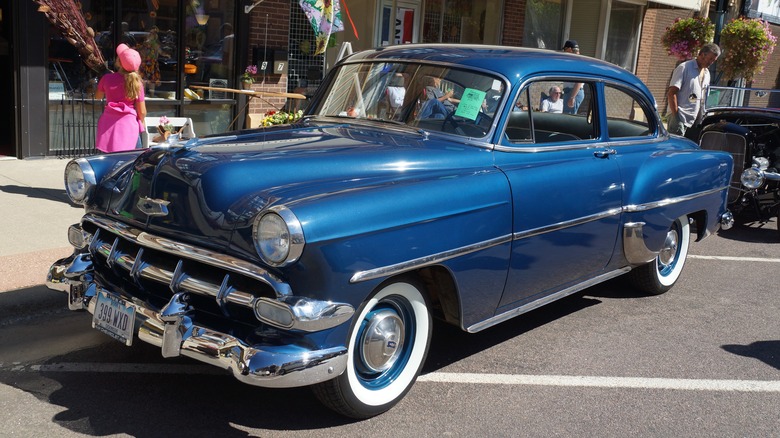All About The Delray, One Of The Quickest Chevrolets Of The 1950s
Chevrolet is one of the oldest car companies in the United States, with a history that goes back to 1911, when displaced General Motors founder William Durant joined forces with Swiss racing driver Louis Chevrolet to form a new enterprise. Their company thrived, and Durant was able to take control of GM again in 1916. Chevy has produced more than 200 million vehicles in its long history, including eight generations of the legendary Corvette and an uninterrupted 90-year run of the Suburban.
That makes that SUV the longest continuously produced nameplate in automotive history, and over its 12 generations, the Suburban has seen many other models come and go from Chevrolet's lineup. While almost everyone knows about the Corvette, Camaro, and Impala, there are some Chevy models that aren't as well known, despite having some impressive performance specs. One such car is the Delray, which deserves inclusion in the conversation with Chevy's best ever despite a comparatively short lifespan.
[Featured image by Greg Gjerdingen via Wikimedia Commons|Cropped and scaled|CC-By SA 2.0]
The Delray wasn't originally a standalone model
The Delray nameplate was first used as a trim package designation on two-door versions of the 210 (sometimes styled as "Two-ten," a full-sized model that sat between the 150 and the Bel Air during its two-generation run from 1953 through 1957.
During the first generation, which covered the 1953 and 1954 model years, the 210 was available with one of two 3.9-liter six-cylinder engines, including the "Blue Flame" I6 powerplant it shared with the first-gen Corvette. When the model was updated in 1955, a 265 cubic inch V8 was added to the option sheet. That engine put out 180 horsepower and carried the Delray from 0-60 in just over 10 seconds. That year, the Delray package included vinyl pleated upholstery that was-matched with the body color. The door panels had the same pattern and color scheme, and Delray models also had upgraded carpeting and some other special interior touches.
[Featured image by Greg Gjerdingen via Wikimedia Commons|Cropped and scaled|CC-By SA 2.0]
Chevy made major changes to the Delray starting in 1957
Beginning in 1957, Chevy made some changes to the Delray to make it a formidable performer. '57 models were available with a 283-cubic inch (4.6 liter) V8 with a variety of fuel delivery configurations, including the brand-new Rochester Ramjet fuel injection system that the Delray shared with the Corvette and select Pontiac models.
On the 1957 Delray, this setup produced 250 horsepower and could get the coupe from 0-60 in 7.5 seconds. For 1958, Chevy finally freed the Delray name from the 210 and put it on a standalone model, bumping the 150 from Chevy's lineup. It was offered in two-and four-door sedan and sedan delivery versions, and a Delray station wagon was badged as the Yeoman. For 1958, the Delray's engine options ranged from the 145 horsepower, 235 cubic inch Blue Flame I6 to a 348 cubic inch V8 that cranked out 315 horses. Car and Driver tested the 1958 Delray in January of the next year and found it "exhilarating, thrilling, and amazing to drive" while timing it at 7.2 seconds in the sprint from 0 to 60 miles per hour. Despite those bona fides, the 1958 Delray is still one of the best bargains on the classic car market. Hagerty values one in good condition at just $10,400, and we found one in prime shape at Worldwide Vintage Autos in Denver for $22,900. After its lone year on the market, the Delray gave way to the Biscayne.
[Featured image by Greg Gjerdingen via Wikimedia Commons|Cropped and scaled|CC-By SA 2.0]


